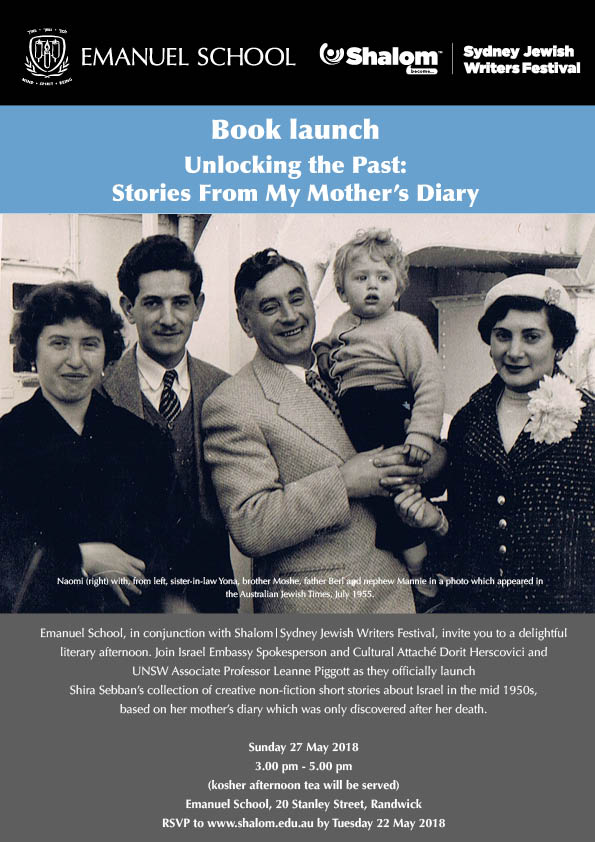Unlocking the Past: Stories from my Mother’s Diary – book review by Jeffrey Cohen
This book, for it is a little larger than a monograph, tells the story of Shira’s mum and her journey in Jerusalem (and getting there and back) as she pursues her PhD at the Hebrew University.

In that, she is just one of many. But this book is set in the 1950s! It is the story of a young woman in her twenties and the experience of being in an emerging country, not yet 10 years old.
There is much written and published about the birth of Israel (say from 1945 to 1950), be it in historical fiction like O Jerusalemor The Sourceas well as shelves of historical and personal accounts. At the other end of the spectrum is more recent works especially those discussing the political and historical (and even economic history) of Israel from the election of Begin in 1977 until today. What is missing is observations of those years between 1950and the Six day War of 1967.
Shira and her sister discovered a diary kept by their mother, Naomi, after her death in 2013 following a long battle with Alzheimer’s disease. It helps give some of the answers to questions they could no longer ask their mother. It is a labour of love.
Naomi Moldovsky was born in Palestine but had settled with her father in Melbourne. In 1955, she had an opportunity to study Economics in Jerusalem [and to become reacquainted with her mother who lived in Tel Aviv]. The book is a series of short vignettes describing events and feelings about what is going around Naomi. It is also set in a time while she is still single for it is only in 1958 that she does marry. She describes how lonely she felt as a single person in Jerusalem.
Many of us forget that this time was less than a decade since Israel’s Declaration of Independence and fighting a war for survival- and during the writing of this journal was the Suez Crisis. Israel then is not he Israel of today. The Labor Party of David Ben Gurion was firmly entrenched at all levels, not only of government but throughout society. Having lost half of Jerusalem and the main campus of the Hebrew University much was on an ad hoc basis. This is reflected, at least on one level, by the description of the location of her supervisor whose offices were in part of Terra Sancta building where both the humanities and the social sciences were located until much later when it was subsequently moved to the Givat Ram.campus.
Some of the book gives one a sense of déjà-vu. Just as in today’s Israel which experiences terrorist action do too it was in the Jerusalem of Naomi’s time. Described are a number of events which happened in April 1956.
What I missed, for not that much is available, is Naomi’s perception of the Suez Crisis. It was a time of uncertainty with world powers vying for control and influence and the United States forcing Israel and its partners back from the Suez Canal.
The reality of this book is in its style. Shira has taken the words of her mother’s diary and written them in an easy to read form that enables the reader to understand that period of time. It is clearly not intended for those seeking primary documents.
Shira has brought her own literary talents to this book. She has previously worked as a journalist and her sister, Leora, is still in the field. It is a fascinating read.
Shira Sebban
Mazo Publishers $20
Rabbi Jeffrey Cohen is Associate Professor of Medicine (Sydney Campus) at the University of Notre Dame Australia. He served as CEO of the Sydney Jewish Museum [1996-2001] and has been involved in Jewish Christian Dialogue and Pastoral/Spiritual Care in North America and Australia

 Most poignant are Sebban’s descriptions of Israel, in its nascent statehood, which transport the reader to a totally different world from today’s start-up nation. Descriptions of armoured plated vehicle convoys to the Hebrew University Mt Scopus campus, the elegant Edison cinema, Jerusalem neighbourhoods newly built on the ruins of Arab villages, and a no mans land occasionally interrupted by sniper fire dividing the Israeli controlled West Jerusalem from the Jordanian controlled East Jerusalem were all very real during Naomi’s stay. She also refers to fascinating interactions she had with newly arrived immigrants from Yemen and Egypt.
Most poignant are Sebban’s descriptions of Israel, in its nascent statehood, which transport the reader to a totally different world from today’s start-up nation. Descriptions of armoured plated vehicle convoys to the Hebrew University Mt Scopus campus, the elegant Edison cinema, Jerusalem neighbourhoods newly built on the ruins of Arab villages, and a no mans land occasionally interrupted by sniper fire dividing the Israeli controlled West Jerusalem from the Jordanian controlled East Jerusalem were all very real during Naomi’s stay. She also refers to fascinating interactions she had with newly arrived immigrants from Yemen and Egypt.